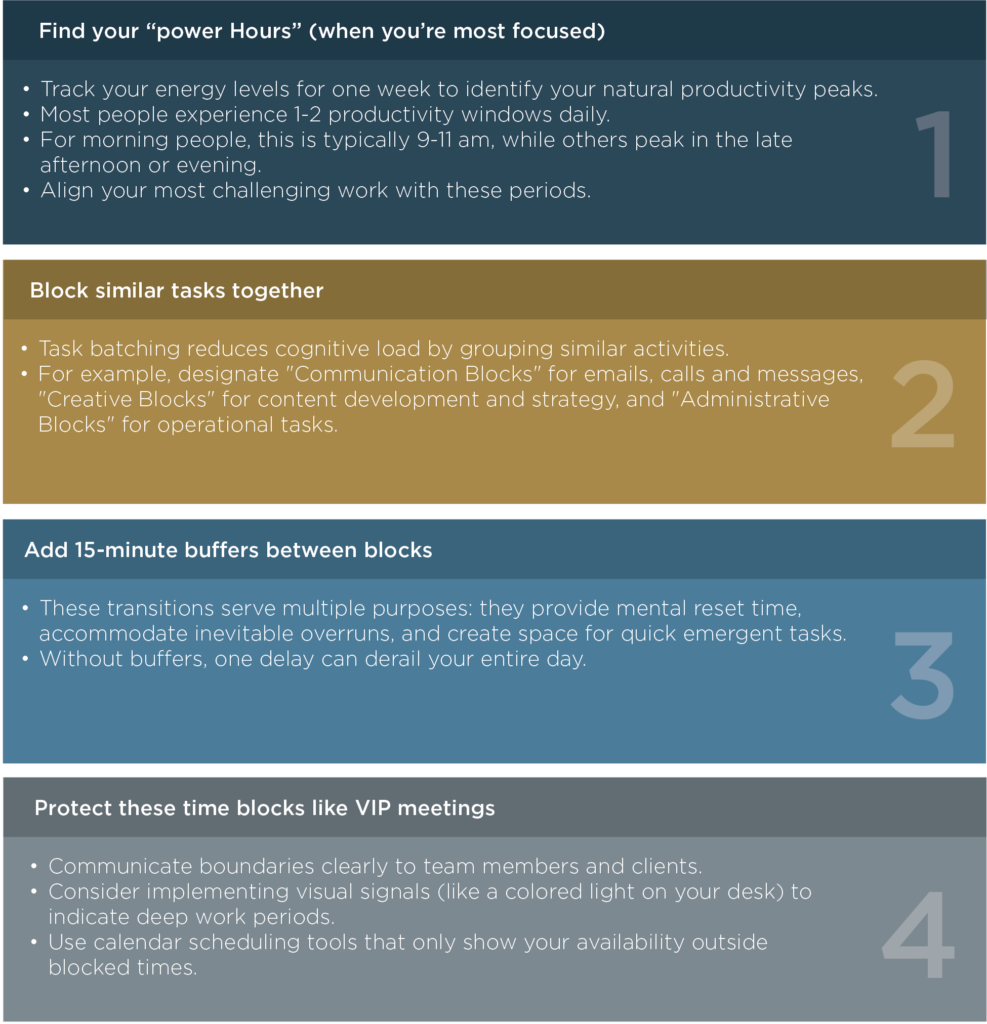Ever feel like there aren’t enough hours in the day? You’re not alone. Most entrepreneurs work a whopping 72 hours per week, yet nearly half that time goes to tasks that don’t directly grow their business. Let’s change that.
Why Time Management Makes or Breaks Your Success
Think of your time like your business bank account. Every minute you spend is an investment that should generate returns. The problem? Most of us are making withdrawals from the wrong accounts, focusing on urgent tasks instead of important ones that drive growth.
The cost of poor time management extends far beyond just feeling busy. Research shows that entrepreneurs who master time management see 23% higher revenue growth compared to those who don’t. Why? Because strategic time use compounds – just like interest in your bank account. When you consistently invest time in high-leverage activities, the returns multiply exponentially.
The cognitive switching penalty is another hidden time thief. Each time you jump between tasks, your brain needs 23 minutes on average to fully refocus. For entrepreneurs who frequently switch contexts, this can waste up to 40% of productive time. This is why multitasking is actually the enemy of productivity.
Effective time management also directly impacts your ability to make quality decisions. Decision fatigue – the deterioration of decision-making ability after a long session of decision making – affects entrepreneurs particularly hard. By the end of a chaotic day filled with constant interruptions, your cognitive resources are depleted, leading to poorer strategic choices.
The Eisenhower Matrix: Your New Best Friend
Remember the last time you felt overwhelmed by your to-do list? Here’s a simple tool that changes everything: the Eisenhower Matrix. Picture a box divided into four squares. Each task falls into one of these categories:
-
- Urgent & Important: The fires you need to put out (client emergencies, system crashes). These require immediate attention but shouldn’t dominate your calendar. If they do, it indicates reactive rather than proactive management. Consider implementing contingency plans and better systems to reduce future emergencies.
- Important but Not Urgent: The growth drivers (strategic planning, team development). This is your productivity sweet spot. Activities here include relationship building, strategic planning, skill development, and preventative maintenance. Successful entrepreneurs deliberately allocate 60-70% of their time to this quadrant.
- Urgent but Not Important: The time-thieves (most emails, unexpected calls). These tasks feel productive but yield minimal returns. The key is implementing systems to handle these efficiently without your direct involvement. Consider:
- Email templates for common responses
- Delegation protocols for team members
- Communication boundaries (specific times for calls/meetings)
- Clear criteria for what constitutes an “emergency”
- Neither Urgent Nor Important: The busy work (endless website tweaking). These activities often masquerade as work but actually serve as procrastination. Be brutally honest about what belongs here. Common culprits include excessive social media management, over-researching decisions, and perfectionist tendencies on low-impact deliverables.
The secret? Successful entrepreneurs spend most of their time in quadrant two – Important but Not Urgent. That’s where real business growth happens. Download our Free Eisenhower Matrix here to start categorizing your to-do list today!
Time Blocking: Your Schedule’s Secret Weapon
Want to know how successful entrepreneurs seem to get more done in 24 hours than others do in a week? They use time blocking. It’s like making appointments with yourself for specific tasks.
The psychology behind time blocking is powerful. It leverages Parkinson’s Law (work expands to fill the time available) by creating artificial constraints that boost focus and efficiency. It also creates psychological safety by ensuring important tasks have dedicated space in your calendar.
Here’s how to make it work:

Pro tip: Start with just one block per day for your most important task. Master that before adding more. The “90-minute accomplishment block” is particularly effective – set aside 90 minutes first thing in the morning to tackle your highest-leverage task before distractions begin. Use our Free Time Blocking Guide to create a time-blocked schedule of your own!
Defeating the Time-Wasters
Those “quick” checks of your email? They’re costing you more than you think. Research shows the average entrepreneur checks email 74 times daily and spends 28% of their workday on email. Here’s what do instead:
- Check email at scheduled times (try twice daily). Implement specific processing protocols: respond immediately to messages requiring less than two minutes, schedule longer responses for communication blocks, and maintain a “waiting for” tracking system.
- Turn off notifications during focus time. Notification anxiety is real – studies show that even seeing a notification (without checking it) reduces cognitive performance by up to 20%. Create technology-free zones both physically (designated spaces) and temporally (specific hours).
- Use “Do Not Disturb” mode during deep work. Configure your tools properly: set up emergency bypass settings for true emergencies, create auto-responders explaining your communication schedule, and leverage AI assistants to categorize incoming requests.
- Schedule buffer time for unexpected issues. Build flexibility into your system with deliberate white space. Many entrepreneurs find success with the 3-2-1 approach: schedule only 3 major priorities, 2 hours of buffer time, and 1 self-care activity daily.
Meeting management deserves special attention as a major time drain. Implement the “meeting trifecta”:

Your Next Steps
Ready to take control of your time? Start small:
- Pick one strategy from this article. Begin with the approach that addresses your biggest pain point. If email overwhelms you, start with communication batching. If you struggle with prioritization, implement the Eisenhower Matrix first.
- Try it for one week. Commit fully to your chosen strategy, tracking both implementation and results. Document challenges and adaptations needed for your specific workflow. Consider finding an accountability partner to share the journey.
- Track the difference in your productivity. Measure both quantitative metrics (tasks completed, revenue-generating activities) and qualitative factors (stress levels, decision quality, team satisfaction).
Remember, mastering time management isn’t about doing more – it’s about doing what matters. The entrepreneurs who thrive aren’t necessarily working longer hours; they’re working smarter hours on the right priorities.
Want to learn how delegation can multiply your productive hours? Check out our next article in the series: Delegation and Workflow Automation: Free Up Your Time to Focus on Growth




